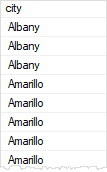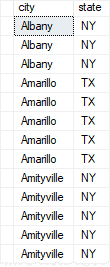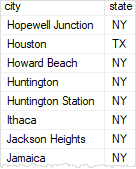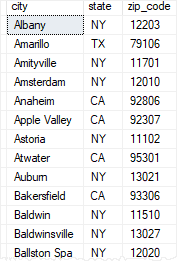Summary: in this tutorial, you will learn how to use the SQL Server SELECT DISTINCT clause to return distinct rows from a result set.
Introduction to SQL Server SELECT DISTINCT clause
Sometimes, you may want to get only distinct values in a specified column of a table. To achieve this, you can use the SELECT DISTINCT clause.
Here’s how you can do it:
SELECT
DISTINCT column_name
FROM
table_name;Code language: SQL (Structured Query Language) (sql)The query will return unique values from the column column_name. In other words, it removes duplicate values from the column_name in the result set.
If you use the DISTINCT clause with multiple columns as follows:
SELECT DISTINCT
column_name1,
column_name2 ,
...
FROM
table_name;Code language: SQL (Structured Query Language) (sql)The query will evaluate the uniqueness based on the combination of values in all the specified columns in the SELECT list. It will return only rows with unique combinations of the specified columns.
When you apply the DISTINCT clause to a column that contains NULLs, it will keep only one NULL and eliminate the others. In other words, the DISTINCT clause treats all NULLs as the same value.
SQL Server SELECT DISTINCT examples
We will use the customers table from the sample database for the demonstration:

1) Using the SELECT DISTINCT with one column
The following statement uses the SELECT statement to retrieve all cities of all customers from the customers tables:
SELECT
city
FROM
sales.customers
ORDER BY
city;Code language: SQL (Structured Query Language) (sql)
The output indicates that the cities are duplicates.
To retrieve only distinct cities, you can use the SELECT DISTINCT keyword as follows:
SELECT
DISTINCT city
FROM
sales.customers
ORDER BY
city;Code language: SQL (Structured Query Language) (sql)
The output shows that the SELECT DISTINCT returns only distinct cities without duplicates.
2) Using SELECT DISTINCT with multiple columns
The following example uses the SELECT statement to retrieve the cities and states of all customers from the customers table:
SELECT
city,
state
FROM
sales.customers
ORDER BY
city,
state;Code language: SQL (Structured Query Language) (sql)
The output indicates that there are duplicate cities & states, for example, Albany NY, Amarillo TX, and so on.
To retrieve the distinct cities and states of customers, you can use the SELECT DISTINCT with the city and state columns:
SELECT
DISTINCT city, state
FROM
sales.customersCode language: SQL (Structured Query Language) (sql)
In this example, the statement uses the combination of values in both city and state columns to evaluate the duplicate.
3) Using SELECT DISTINCT with NULL
The following statement finds the distinct phone numbers of customers:
SELECT
DISTINCT phone
FROM
sales.customers
ORDER BY
phone;Code language: SQL (Structured Query Language) (sql)
In this example, the DISTINCT clause keeps only one NULL in the phone column and removes other NULLs.
DISTINCT vs. GROUP BY
The following statement uses the GROUP BY clause to return distinct cities together with state and zip code from the sales.customers table:
SELECT
city,
state,
zip_code
FROM
sales.customers
GROUP BY
city,
state,
zip_code
ORDER BY
city,
state,
zip_codeCode language: SQL (Structured Query Language) (sql)The following picture shows the partial output:

It is equivalent to the following query that uses the DISTINCT operator :
SELECT
DISTINCT city, state, zip_code
FROM
sales.customers;Code language: SQL (Structured Query Language) (sql)Both DISTINCT and GROUP BY clause reduces the number of returned rows in the result set by removing the duplicates.
However, you should use the GROUP BY clause when you want to apply an aggregate function to one or more columns.
Summary
- Use the SQL Server
SELECT DISTINCTclause to retrieve the distinct values from one or more columns.